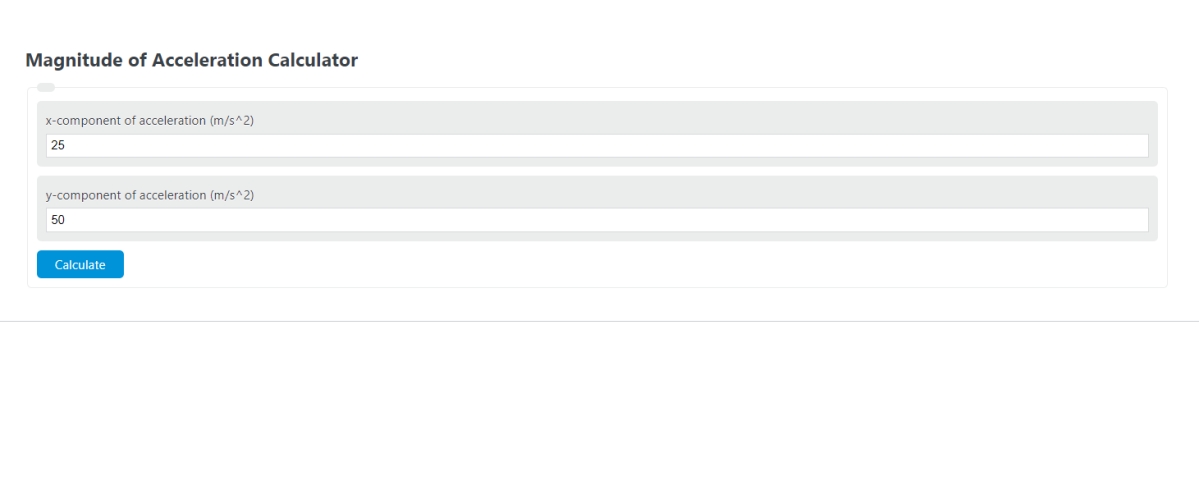Enter the x-component of acceleration, and the y-component of acceleration, into the calculator to determine the Magnitude of Acceleration.
- All Acceleration Calculators
- Average Acceleration Calculator
- Angular Acceleration Calculator
- Centripetal Acceleration Calculator
- Vector Acceleration Calculator
- Vertical Acceleration Calculator
- Uniform Acceleration Calculator
- Angle of Acceleration Calculator
Magnitude of Acceleration Formula
The following equation is used to calculate the Magnitude of Acceleration.
A = SQRT ( Ax^2 + Ay^2)
- Where A is the Magnitude of Acceleration (m/s^2)
- Ax is the x-component of acceleration (m/s^2)
- Ay is the y-component of acceleration (m/s^2)
To calculate the magnitude of an acceleration vector, sum the squares of the x and y components of the acceleration, then take the square root.
What are the units for Magnitude of Acceleration?
In the International System of Units, also known as SI units, the units for Magnitude of Acceleration are m/s^2.
How to Calculate Magnitude of Acceleration?
Example Problem:
The following example problem outlines the steps and information needed to calculate the Magnitude of Acceleration.
First, determine the x-component of acceleration. In this example, the x-component of acceleration is calculated or measured to be 25 (m/s^2).
Next, determine the y-component of acceleration. For this problem, the y-component of acceleration is determined to be 50 (m/s^2).
Finally, calculate the Magnitude of Acceleration using the formula above:
A = SQRT ( Ax^2 + Ay^2)
Inserting the values from above and solving the equation with the imputed values gives:
A = SQRT ( 25^2 + 50^2) = 55.901 (m/s^2)
FAQ
What is the significance of calculating the magnitude of acceleration in physics?
The magnitude of acceleration is crucial in physics as it quantifies the rate of change of velocity of an object. It is a scalar quantity that gives us an idea of how quickly an object is speeding up or slowing down, irrespective of its direction. This is particularly important in understanding motion dynamics, designing mechanical systems, and analyzing forces in engineering and physics.
How does the direction of acceleration affect an object’s motion?
The direction of acceleration plays a vital role in determining the trajectory of an object’s motion. If the acceleration is in the same direction as the object’s velocity, the object speeds up. If the acceleration is in the opposite direction to the object’s velocity, the object slows down. When the acceleration is perpendicular to the velocity, the object changes direction but maintains its speed. This concept is fundamental in circular motion and orbits.
Can the magnitude of acceleration be negative?
No, the magnitude of acceleration cannot be negative. Magnitude, by definition, refers to the size or length of a vector and is always a non-negative value. However, the components of acceleration (such as the x or y components) can be negative, indicating direction, but when these components are squared and summed to find the magnitude, the result is always positive.
